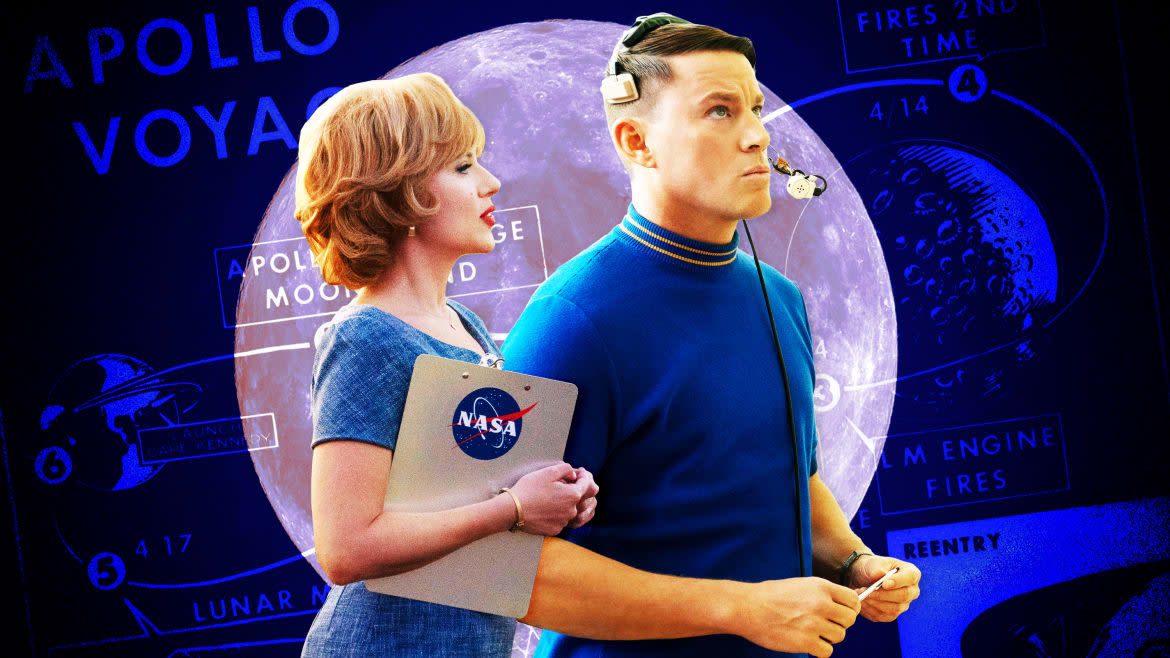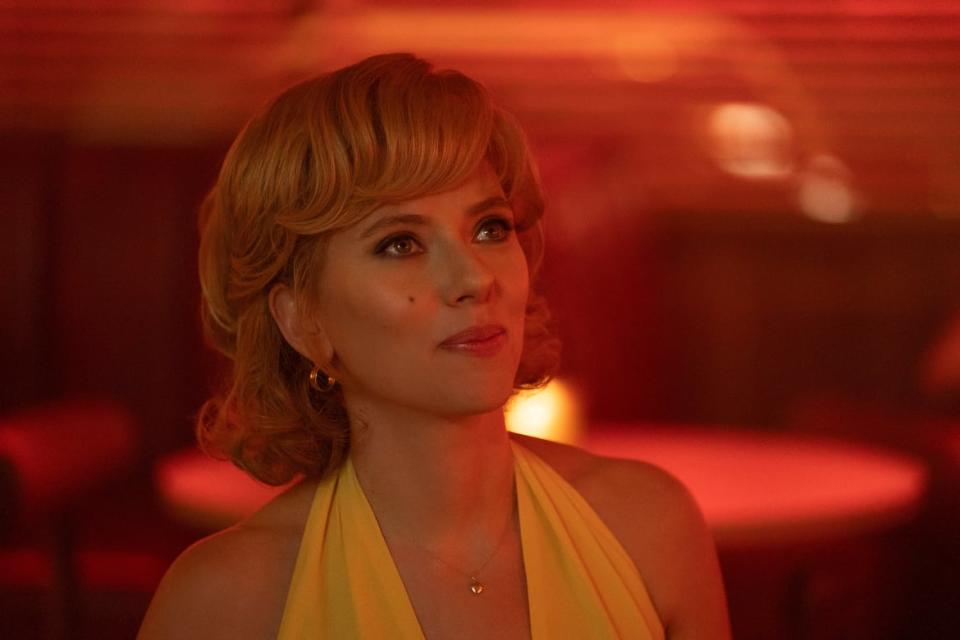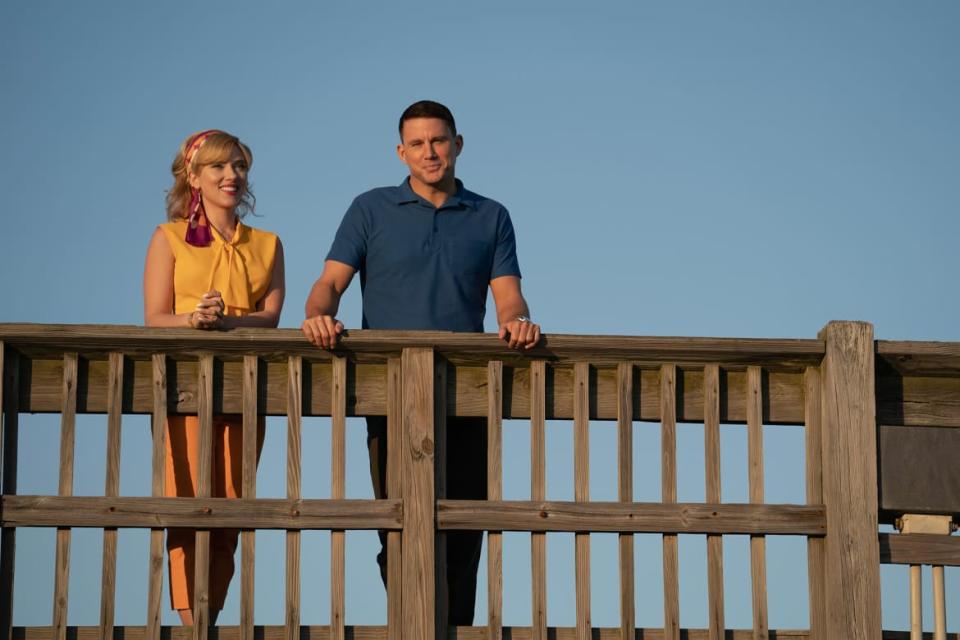ScarJo and Channing Tatum’s New Rom-Com Disastrously Thinks It’s a Drama

A romantic comedy with delusions of dramatic grandeur, Fly Me to the Moon (July 12, in theaters) has a frothy premise that it treats with a dismal degree of seriousness.
Director Greg Berlanti’s film boasts two likable stars in a story that playfully riffs on a well-known conspiracy theory about the historic Apollo 11 moon landing. Yet rather than using its cheeky conceit for zippy humor and enticing amour, it spends excessive time on trauma, guilt, regret, and other heavy topics that are as ill-fitting as they are superficially handled. Aiming for the stars, it proves a laborious affair that rarely gets off the ground.
In Manhattan circa the late ’60s, Kelly Jones (Scarlett Johansson) is a hotshot ad executive who fakes a pregnancy while delivering a dynamite pitch that charms the pants off chauvinistic Ford executives. Kelly is a proto-Don Draper and, as is soon revealed, also a female Saul Goodman—a con woman in cute period outfits who’s operating under one of numerous false identities. This is precisely what makes her so appealing (and manipulatable) to Moe Berkus (Woody Harrelson), a shadowy employee of President Richard Nixon who wants Kelly for a job of the highest priority: selling the upcoming moon landing to the American public.
Made head of NASA public relations, Kelly travels to Cape Canaveral, where she immediately clashes with Cole Davis (Channing Tatum), the gruff, no-nonsense launch director who wears myriad variations of the same tight-necked shirt. Cole’s heroic success detecting a gas leak with a broom indicates that he does things the old-fashioned way—which, it turns out, means honestly. To him, Kelly is not merely a Madison Avenue interloper but a fundamentally deceitful person who cares more about profit than true American values like loyalty and sincerity. Thus, Fly Me to the Moon establishes its core conflict, with Cole dedicated to people and truth, and Kelly prioritizing products and lies.

Scarlett Johansson.
This would be a fine setup were the film interested in generating lively momentum. Yet despite Kelly sticking Apollo astronauts Neil Armstrong, Buzz Aldrin, and Michael Collins on boxes of Rice Krispies, the action lacks requisite snap, crackle, and pop. Cole bristles at Kelly’s desire to promote the moon landing via partnerships with Omega, Tang, and Chevrolet, but he reluctantly concedes that it brings in the revenue that the struggling aerospace agency needs. He’s unhappier about Kelly’s demand (pushed by Moe, who habitually shows up unannounced like the nefarious spook he is) that a camera be attached to the exterior of Apollo 11 in order to broadcast Armstrong’s giant leap for mankind to a global TV audience. From a plot standpoint, this is preposterous; the idea that NASA wouldn’t have documented this groundbreaking voyage strains even these proceedings’ credibility. Worse, however, is that it’s not consistent with the material’s single theme, since Cole—a stickler for integrity—should want to faithfully present this achievement to the world.
The veracity of the moon landing (and its public presentation) winds up being central to Fly Me to the Moon, which eventually pivots around Moe ordering Kelly to orchestrate a fake version of the landing as a backup plan in case the actual mission goes awry. This supposed fail-safe is produced on the NASA base in a heavily guarded hanger and overseen by Kelly’s favorite director, Lance Vespertine (Jim Rash), whose prima-donna flamboyance is supposed to be funny. His dull unimaginativeness extends to the rest of the film’s supporting characters, who are barely allowed to try to be witty. This goes for Kelly’s anti-Nixon assistant (Anna Garcia) and Cole’s wet-behind-the-ears engineers (Noah Robbins, Donald Elise Watkins), and it’s especially true about Cole’s featureless right-hand man, Henry Smalls (a squandered Ray Romano), whose sole purpose is to relay his boss’ greatness to Kelly.
Cole is deliberately kept in the dark about Kelly’s top-secret project, which is based on the long-standing tall tale that the moon landing was filmed on a soundstage by Stanley Kubrick, who’s name-checked twice, bleakly, to hammer home the link. As they both endeavor to get Armstrong, Aldrin, and Collins to the lunar surface, Cole and Kelly slowly strike up a romance—emphasis on the word “slowly,” as Fly Me to the Moon drags its feet at almost every turn, though its steps are painfully predictable. Rose Gilroy’s script can’t concoct a single plausible reason that Cole and Kelly like each other aside from him finding her hot and vice versa, and the notion that the two share an opposites-attract spark is more of a contrivance than a palpable reality. No matter Johansson and Tatum’s inherent charisma, they boast little chemistry—a byproduct of the ponderous screenplay as much as their game performances.

Scarlett Johansson and Channing Tatum in Fly Me to the Moon.
Fly Me to the Moon is full of scenes that are narratively and thematically redundant, not to mention tonally inapt, lowlighted by a TV interview in which Cole loses it when pressed about his culpability in the Apollo 1 tragedy. At regular intervals, the film affects a solemnity that’s incompatible with the bedrock cartoonishness of everything from its characterizations and interpersonal dynamics to its simplistic portrait of the space program itself (listening to Tatum talk about mission specifics is hard on the ears). Rather than gearing things toward light and frivolous zaniness, Gilroy steers his saga into earnestness. In the process, he so sabotages any silly energy that when he attempts, during the climax, to elicit chuckles from the sight of fake astronauts crashing into each other, the effort comes off as strained and futile.
Adhering to the principle of Chekhov’s gun, a black cat that drives Cole mad at the outset of Fly Me to the Moon winds up being the catalyst for surprising triumph. Even if it isn’t bad luck, though, the feline is an uninspired device in a film brimming with them. Dreariest of all is a finale that goes on and on recreating the Apollo 11 enterprise from various pedestrian angles, conjuring zero suspense and awe while distending this venture to unmanageable lengths. At a whopping 132 minutes, Berlanti’s latest feels almost as long as its famous interstellar expedition—and is infinitely less memorable.
Get the Daily Beast's biggest scoops and scandals delivered right to your inbox. Sign up now.
Stay informed and gain unlimited access to the Daily Beast's unmatched reporting. Subscribe now.


